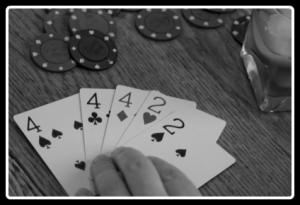
Tip your hand, don't show it! (Photo by Shannon Iverson)
When I was in Middle School some of the older kids in our youth group went off to camp and came back fascinated with a new card game called Mao. I don’t know if you’ve played it, and I don’t know that we were playing according to standard rules, but the game became wildly popular at all our youth events for months after.
It’s a cruel and capricious game. The rules are arbitrary and punishing, made up game-to-game (or even hand-to-hand) by the dealer, or “Mao Master.” The goal of the game is to get rid of the cards in your hand, but the Mao Master can give a player an extra card at any time, for any offense. I’m pretty sure I’m the one who implemented “card for not having enough cards,” and “card for having too many cards.”
Yeah. We played this game for fun.
Show, Don’t Tell
Writing advice can often feel a lot like that cruel little game. You might have run into that yourself, from time to time. One person tells you to use strong and varied language, but someone else exhorts you to throw your thesaurus in the trash. One person tells you to develop your unique voice, make your prose conversational, but someone else tells you to fix your comma splices and get rid of those awful sentence fragments.
Some of the most frustrating examples of this are in some of the most common writing advice, especially in the phrase, “Show, don’t tell.” It’s vague and unhelpful, but you’ll hear those words again and again and the harder you try to do it, the more people might complain about it.
I’ll write an article soon explaining how best to use that phrase (both as a writer and as an editor), but today I want to talk about the difficulty of hitting that moving target.
Beauty in Brevity
I’m sure you’ve heard the phrase “efficiency of language” given as high praise. There is a beauty, a special kind of magic, in saying something profound in a handful of words.
When I’m advising new writers, I find myself again and again saying, “Get out of the characer’s head!” Tell us the story. Tell us what happens. I get frustrated with too much introspection, too much explanation.
I get just as frustrated with too much description. I’ve already complained about Stephen King, and I could be just as vicious concerning the late Robert Jordan’s pages-long descriptions of every character’s every bit of clothing. It’s agonizingly detailed, and it shatters the flow of the story.
Clarity is King
Of course, even as I say that, I know there are people who love Stephen King precisely for his detailed visual descriptions. Jordan’s fame came from his worldbuilding — his engaging sets and the amazingly real (but novel) societies and cultures. Part of the problem is that every reader is different, every audience varied, so there is no one right way to write.
It is important to make your story clear, though. Make it real to your reader. Your job is to provide as much detail as necessary to make your story bloom, in perfect clarity, in your reader’s mind. You’ll get to choose, to some extent, which readers are your readers, and most of the time the right way to do that is to pick readers like you. Write the level of detail you like in a novel, and don’t waste too much effort tweaking to please people with fundamentally different taste.
Focus on the Story
Ultimately, though, your job is to tell a story. Your readers come to you not for your genius turns of phrase, not for your lovely dress designs, but for your story. Whether you’re chasing brevity or clarity, you should be doing it to better tell your story. Make it a tale. Make it an engaging experience on every page.
Sometimes it’s tempting to tell your readers what else is going on, or what has gone before. Sometimes it’s tempting to tell your readers why your characters are doing what they’re doing, or why an obstacle has arisen. That’s when “Show, don’t tell” matters most. It’s better to tell your story than tell about your story.
I call that sort of writing “cards on the table” because it’s like playing a round of poker with your hand face-up. Maybe you’re doing it out of generosity, but it ruins the game. Readers want to figure it out. Part of the experience of reading a story is looking for the subtext, guessing at ulterior motives, reading people.
It’s fair to think of it just like a poker game. It’s a game you want your readers to win, sure, but you’ve got to play according to the rules. So give your characters tells — your love interest hesitates before she says, “I love you, too.” Your villain flashes the barest hint of a smile before he shakes his head and says, “A bitter tragedy.”
You don’t have to say why, just say what they do, and leave it to your readers to call the bluffs.






Totally unrelated to the writing aspect of your post: We used to play this game in Germany when I was a kid. There, it’s called “Mau Mau”…and I wasn’t any good at it, if I recall correctly.
I hope that’s not prophetic concerning my writing career. ;oD